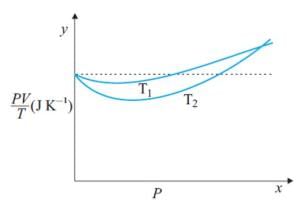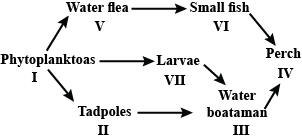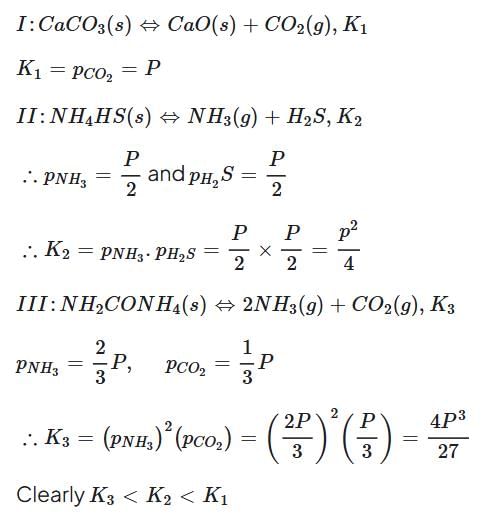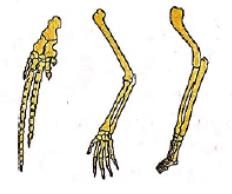NEET Unit Test - 3 - NEET MCQ
30 Questions MCQ Test - NEET Unit Test - 3
Mobilities of electrons and holes in a sample of intrinsic germanium semiconductor at room temperature are 0.36m2/volt-sec and 0.17 m2/volt-sec respectively. If the electron and hole densities are each equal to 2.5 X 1019/m3, the conductivity is ______.
One mole of hydrogen gas is heated at constant pressure from 300 K to 420 K. Calculate the energy transferred by heat to the gas
1 mole of a monoatomic gas is mixed with 3 moles of a diatomic gas. What is the molecular specific heat of the mixture at constant volume?
Figure shows plot of PV/T versus P for 1.00x10-3 kg of oxygen gas at two different temperatures. What is the value of PV/T where the curves meet on the y-axis?

One mole of an ideal monatomic gas is at an initial temperature of 300 K. The gas undergoes an isovolumetric process, acquiring 500 J of energy by heat. It then undergoes an isobaric process, losing this same amount of energy by heat. Determine the work done on the gas.
A source (S) of sound has frequency 240 Hz. When the observer (O) and the source move towards each other at a speed v with respect to the ground (as shown in Case 1 in the figure), the observer measures the frequency of the sound to be 288 Hz. However, when the observer and the source move away from each other at the same speed v with respect to the ground (as shown in Case 2 in the figure), the observer measures the frequency of sound to be n Hz. The value of n is _______.

Mobility of electrons in a semiconductor is defined as the ratio of their drift velocity to the applied electric field. If for an n-type semiconductor, the density of electrons is 1019 m–3 and their mobility is 1.6 m2 /(V-s) then the resistivity of the semiconductor (since it is an n-type semiconductor contribution of holes is ignored) is close to
Calculate the change in internal energy of 3.00 mol of helium gas when its temperature is increased by 2.00 K.
Assume following equilibria when total pressure set up in each are equal to 1 atm, and equilibrium constant (Kp) as K1; K2 and K3
Thus,
What product are formed during the electrolysis of a concentrated aqueous solution of sodium chloride using an electrolytic cell in which electrodes are separated by a porous pot?
I. Cl2(g)
II. NaOH(aq)
III. H2(g)
IV. NaClO(aq)
V. NaClO3(aq)
Select the correct choice.
When hydrochloric acid is added to cobalt (II) nitrate solution at room temperature, the following reaction takes place
Q. The solution is blue at room temperature. However, it turns pink when cooled in a freezing mixture. Based upon this information, which of the following expression is correct for the forward reaction?
For the redox reaction,
MnO4– + C2O4 2– + H+ → Mn2+ + CO2 + H2O
The correct coefficients of the reactants for the balanced equation are
In a sample of pure water, only one of the following statements is always true at all conditions of temperature and pressure.
Which of the following processes does not involve either oxidation or reduction?
Of the following reactions, only one is a redox reaction. Identify it
The notation p and q of the Hardy Weinberg equation represent ________ of a diploid organism.
Which of the following factors influence the Hardy-Weinberg equilibrium?
i. Gene migration
ii. Genetic drift
iii. Mutation
iv. Reproduction
v. Genetic recombination
Match column I with column II and select the correct option from the given codes.
First 'Earth Summit' for Convention on Biological Diversity' (CBD) was held at
What does the shape of the given age pyramids reflects about the growth status of the related population?

In a given population of 2000 individuals, 80 births and 125 deaths were reported over a given period of time. Which of the following graphs will correspond to it?
Study the food web given below and answer the questions that follow.

Which of the following organisms in the given food web acts as a secondary consumer?
Assertion (A): Nutrient cycling includes both gaseous and sedimentary cycles, which play crucial roles in ecosystem health.
Reason (R): The gaseous cycle relies solely on the atmosphere as its reservoir, while the sedimentary cycle depends on the Earth's crust.
In a laboratory population of fruit flies, if 4 individuals died during a specified time interval and the population had 40 fruit flies, what is the death rate?
Hugo de Vries did an experiment on which plant to prove mutation theory?
Which one of the following fish is being illegally introduced for aquaculture purposes and is posing a threat to the indigenous catfishes of Indian rivers?
Who proposed that the first form of life could have come from pre-existing nonliving organic molecules?
The following are some major events in the early history of life
P. First heterotrophic prokaryotes
Q. First genes
R. First eukaryotes
S. First autotrophic prokaryotes
T. First animals
Which option below places these events in the correct order?



 Hence the value of PV/T where the curves meet on the y-axis is 0.26 jK-1
Hence the value of PV/T where the curves meet on the y-axis is 0.26 jK-1



























